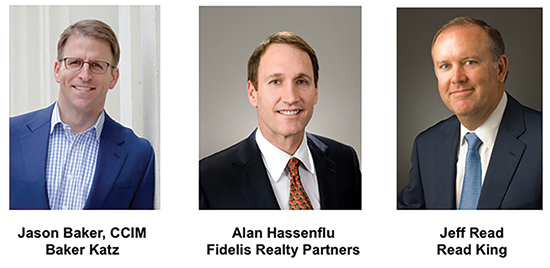Retail is booming in almost all sectors of the area, with the Grand Parkway being the driver in many cases, according to a panel of local retail experts speaking at a sold-out crowd at the April 14 CCIM luncheon.
The Grand Parkway expansion along with pent-up demand due to major population growth is causing massive retail development to satisfy consumers’ needs. Retail centers of all types and sizes along with grocery and discount stores are being developed where population increases have occurred during the last few years. High land prices, an obstacle to new development, is still the norm, although one panelist, Alan Hassenflu with Fidelis Realty Partners, said not having to compete with multi-family developers could help lower land prices for retail development.
Diversity in types of retailers is also being seen. Emergency room care along with other medical-type facilities have emerged as a big part of the leasing picture, according to Jeff Read with Read King. He noted that today’s medical industry has changed, and he said some type of medical group leased space in each of his newer projects. “There’s a new delivery model, come to the people,” he said, referring to back when he was younger, everyone drove to the nearest hospital, usually not in the suburbs, and waited in the emergency room for emergency care. He also noted that free-standing medical facilities are taking over what used to be called the bank pads, the parcel of land in front of a larger retail center, because medical groups currently pay the highest.
Jason Baker, CCIM, with Baker Katz, said needs differ for each retailer, but most are clearly looking at distance from the competitor in addition to the population, i.e., where the people are. A few larger retailers, such as Walmart and Kroger, are opening similar stores close to each other, something usually not done, in order to capture higher market shares in addition to the strong sales, Read noted. He said that with the opening of the Grand Parkway, retail is “way behind” the residential growth, and there are still lots of areas in certain geographic bands poised for more retail.
Other retail trends mentioned include smaller stores, even for the larger grocers, along with reformatted stores, compressing the square footage as much as possible for even the smaller stores. Costco is one retailer currently looking at new prototypes along with major expansion in the area, while Walmart is looking to reformat its superstore design. Baker predicts some fallout from the major grocer expansion, with the smaller grocers being affected far more than the larger one. Some larger grocers, like Whole Foods, is introducing the smaller, lower-cost 365 store concept and products, hoping to increase their profit margin on their name brands as they compete against the national brands.
Other retailers, currently online only, are opening small locations but do not stock large quantities of the merchandise; customers can take a look at the merchandise and order it from the store for delivery. Katz said online retailers currently account for about 6% to 7% of total retail sales, a relatively small percentage. He noted that those online-only retailers are investing in a small physical presence while the large store retailers, like Walmart for example, is investing heavily in online merchandising.



